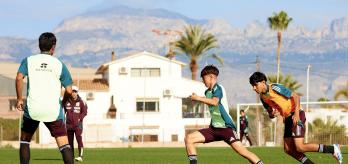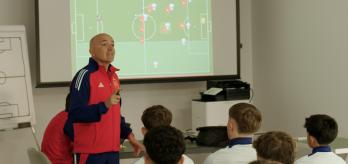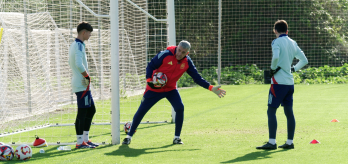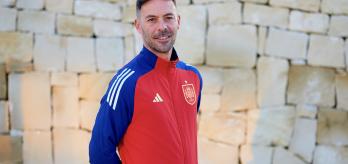Two days prior, the team played its first international match of the season against Spain. Despite executing certain phases of the game well, mistakes were made. However, in today’s fixture, he wants to see that his players have learned from their errors, demanding that they leave everything on the pitch.
Game plan and formation
Mexico are deploying a 4-3-2-1 formation to create numerical superiority in the centre of the pitch. This setup allows them to overload central areas, facilitating quick combinations and intricate passing sequences to break through defensive lines.
(02:00 min) Defensive organisation
Zone 3:
-
Castro expects his team to defend in a 4-4-2 diamond. Forming a U-shape, they are tasked with surrounding the ball and pressing from the front to force a mistake.
-
If the opponent's goalkeeper plays directly to the full-back positioned deep, the forward on that side presses the full-back, and the rest of the team follows.
-
If the ball is played to the centre-back, the forward on that side presses him with a curved run, ensuring to close off one side of the pitch.
-
If the opposition push their full-backs high up the pitch when building from the back, Castro tells his team not to pressure the centre-backs or goalkeeper, but rather to congest the middle and block central passes.
Zone 2:
-
In zone 2, the Mexico players are again expected to congest the middle of the pitch to limit line-breaking passes. Castro instructs them to leave the wide areas open and shuffle across the pitch as the ball moves in front of them.
-
Furthermore, the players should be alert and ready to steal possession of the ball.
Zone 1:
-
In zone 1, Castro expects the team to be in a compact 4-5-1 block, with every player behind the ball, and working hard to prevent crosses and through balls.
-
When the ball is played out wide, the defensive midfielder drops into the backline to provide support to the defenders.
(06:45 min) Offensive organisation
-
In the build-up phase, when playing short, Castro wants his centre-backs to stay deep, while the full-backs move wide This creates space for the midfielders and forwards to receive the ball in the centre and combine as they progress up the pitch.
-
When playing long, Mexico’s centre-back, Dylan Reyes, is expected to take the goal kicks. The wingers position themselves wide, the striker moves laterally to one side for the long ball, and the remaining outfield players cluster centrally in the middle to win the first or second ball.
-
In the final third, the full-backs are instructed to deliver crosses into the box, with forward players ensuring a strong presence at the front post and providing an option around the penalty spot for a cut-back cross.
-
To prevent counter-attacks, he urges his players to recover loose balls and commit tactical fouls high up the pitch if necessary.
-
In terms of defensive cover, the team should maintain numerical superiority at the back, ensuring the deepest player remains free from being marked.
(08:05 min) Set pieces
Mexico’s assistant coach, Israel Hernández, walks the players through their set-piece responsibilities.
-
First corner of the game (one-hand signal): The corner taker will target the player at the back post, using the team's near-post runs to create space in the target zone. This routine can be repeated during the game at the taker's discretion, but they can also aim for the near post to confuse the opposition.
-
Offensive corner routine (two-hand signal): The corner taker can deliver the cross to either post, while the four target players attack at speed, crossing their runs to shake off markers.
-
Defensive corners: Hernández instructs the team to defend corners with five players marking in a player-oriented manner — two positioned close to the near post, two at the edge of the penalty area, and one higher up the field. If the opposition plays the corner short, the near post defender and the player at the edge of the box leave their positions to defend. Meanwhile, the player higher up the field drops back to provide cover at the edge of the penalty box.
-
Defensive lateral free-kicks: Mexico defend these with seven players marking zonally in one line.One player from the wall is tasked with being an outlet in case of a transition to attack, while another is stationed at the edge of the box, ready to deal with second balls.
Castro concludes the team talk by reiterating the team’s fighting spirit, saying that playing for the national team must come from the heart. Players need to fight throughout the entire game. That is the true Mexican spirit.



















